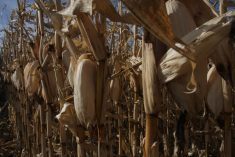Record American soybean and corn crops are still in the official forecast but too much of the North American plains remains dry or in drought to allow crop markets to relax.
A large part of the Canadian Prairies is in drought, threatening canola, durum, spring wheat and other crops.
In the United States, July has brought improved conditions for Iowa and Illinois, but it has become drier in North Dakota and Minnesota.
Reports from the U.S. Department of Agriculture in recent weeks have affected prices.
Read Also

Storm dynamics and extreme rainfall
Besides moisture, instability and orographic lift, the next biggest factor that contributes to heavy or extreme rainfall is storm dynamics.
Its planting report showed farmers seeded more corn and fewer soybeans than expected. This lifted soybean prices and depressed corn.
But last week’s monthly supply and demand report was notable in that it trimmed the forecast for U.S. average corn yield, a rare move so early in the growing season.
Even with the decline, the USDA corn yield forecast of 177.5 bushels per acre would be a record. The production forecast of 15.32 billion bu. is also a record.
But it would not surprise me to see further yield forecast declines in coming months because even with improved moisture in recent weeks in Iowa and Illinois, national corn crop condition ratings remain below the 10-year average. As I noted, soybean futures rose on the surprise reduction in U.S. seeded acreage and the continued worry about moisture, especially as we move into August, the month with the greatest impact on the oilseed’s yield. The Midwest has mostly avoided the heat waves seen elsewhere in the U.S. this summer. If the heat did shift into Iowa and Illinois in August, stress on soybeans would rise.
Crop market prices generally declined during seeding because planting advanced quickly without rain delays. Price lows were reached at the end of May, but they started rebounding in June.
From June 1 to July 14, new crop soybeans advanced 17.3 percent. Soy oil climbed more, gaining 28.2 percent in the same period.
November canola futures rose even more, climbing 29.5 percent in the period as dry weather dominated in most of Saskatchewan, Manitoba, southern Alberta and the Peace River region.
The Saskatchewan crop report said that as of July 10, 48 percent of canola was in good to excellent condition, 36 percent was fair and 16 percent was poor to very poor.
That shows a decline since the end of June when 66 percent of canola was good to excellent, 26 percent was fair and only seven percent was poor to very poor.
Long-range forecasts into August show little chance for major widespread rain relief for the dry parts of the Prairies.
The dry weather on the Canadian Prairies and in large parts of North Dakota is also supporting spring wheat and durum markets, but wheat prices are not climbing as much as oilseeds.
The USDA’s July supply and demand report said the country’s winter wheat crop was a little larger than forecast in June. Rain just before harvest helped fill kernels. However, rain continues to interfere with harvest in western Kansas. Late flushes of weeds are a problem, but there are no reports of quality downgrades. Indeed, protein levels in hard red winter wheat are reported strong.
Strategie Grains last week further trimmed its forecast for the European Union’s soft wheat output, dropping it to 126.2 million tonnes down 2.5 million from May. It is almost one percent more than last year.
Expectations are for a good wheat crop in Russia. It won’t be as spectacular as last year, but with a large carry in from the previous crop year, its total supply will be more than ample, leading to expectations for a record 2023-24 export program. Indeed, Russian wheat exports in July alone could reach a monthly record high.
This huge Russian supply was one reason why the market did not get too excited when Russian president Vladimir Putin on July 17 did not renew the Black Sea agreement that allowed Ukraine to export grain by sea.
The export agreement had been in doubt for some time so the futures market had already adjusted. Also, Ukraine has improved its overland export capability compared to when the war began.
Russia is not the only country with a strong export program. Brazil is shipping corn and soybeans at breakneck speeds thanks to record crops there. The second corn crop, now being harvested, is 98 million tonnes, up from 85.9 million last year, pushing total Brazilian corn production to 127.77 million, up from 113.13 million last year, according to figures from Conab.
The shift to an El Nino in the equatorial Pacific means there is an increased chance for improved moisture in Argentina and southern Brazil and could mean even larger production in the coming months from South America.
But drier weather from El Nino is the norm for the western Pacific, so wheat and canola from Australia could be down while palm oil from Indonesia and Malaysia could suffer.
China’s corn and soybeans, which are concentrated in the northwest part of the country, have received good rain in recent weeks, improving prospects there after a heat wave in early June















